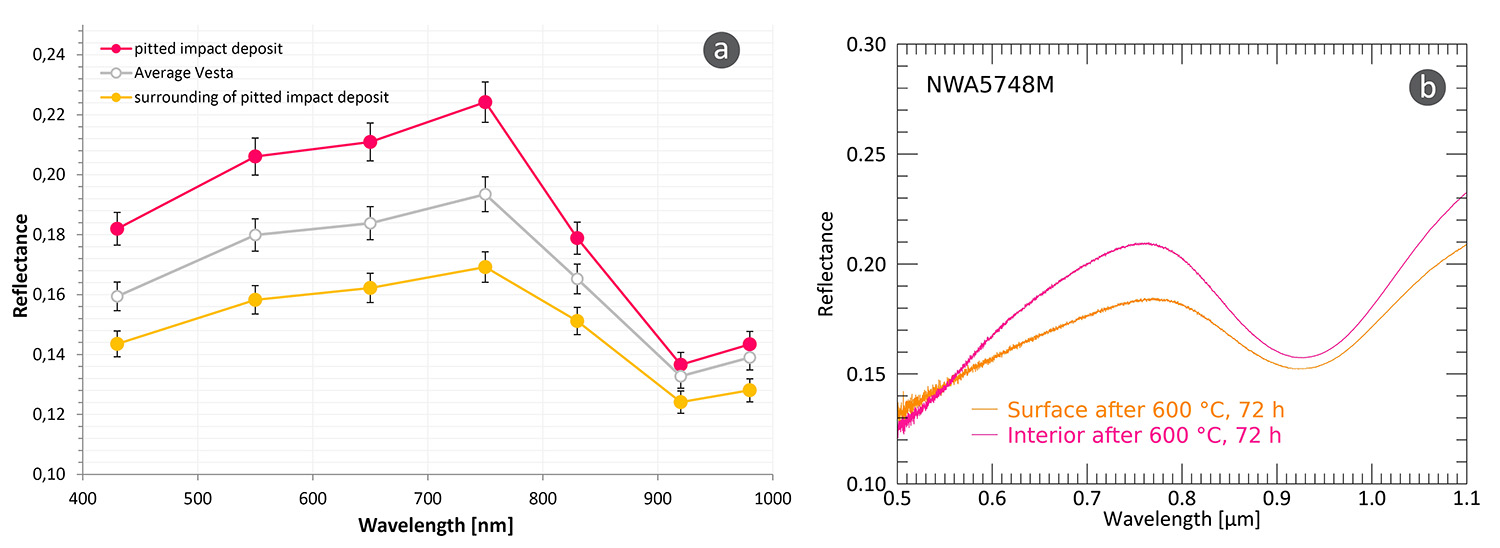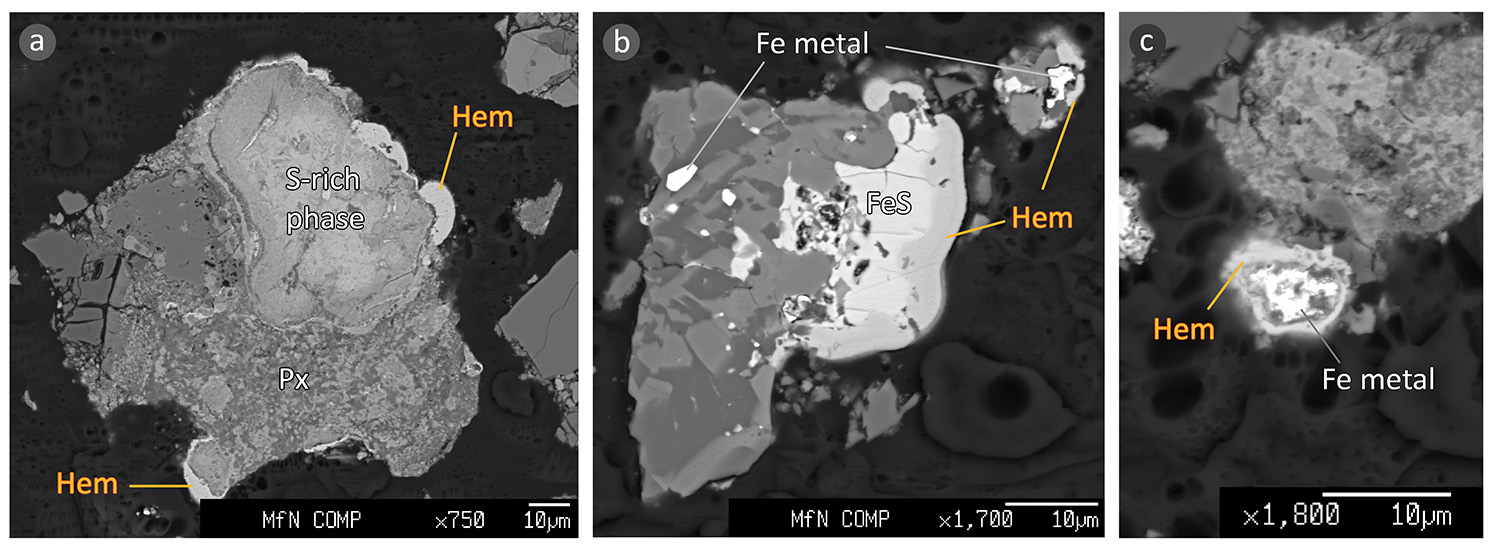How and why can oxidation influence the reflectance spectrum of pyroxenes on planetary bodies?
- 1Museum für Naturkunde Berlin, Solar System, Impacts & Meteorites, Germany (tanja.michalik@mfn-berlin.de)
- 2Institut für Planetenforschung, Deutsches Zentrum für Luft- und Raumfahrt e.V., Rutherfordstr. 2, 12489 Berlin, Germany
- 3Department of Geography, University of Winnipeg, 515 Portage Avenue, Winnipeg, MB, R3B 2E9 Canada
Here we present a summary and outlook of studies looking into and trying to understand the geomorphology and spectral appearance of devolatilization morphologies on the asteroid Vesta. These studies include remote observations and analysis of multispectral reflectance data obtained by NASA’s Dawn mission [1,2], heating experiments and reflectance measurements [3] executed at the Planetary Spectroscopy Laboratory [4] as well as observations and measurements via Electron Probe Micro Analysis [3].
The abovementioned devolatilization morphologies are the so-called pitted impact deposits (PIDs), which present themselves as densely clustered, polygonally-shaped pits [5] (Fig. 1a) within ejecta deposits. These PIDs show distinct spectral properties, whereas the exact cause(s) are still uncertain. The pyroxene-dominated reflectance spectra of the surfaces of these PIDs are characterized by higher overall reflectances in the visible and near-infrared light, more pronounced mafic absorption bands (Fig. 1b & 2a) and lower OH abundances (Fig. 1c) with respect to the adjacent material of the same ejecta deposit. PIDs mostly occur widely around one large, relatively young crater on Vesta [5, 1]. Some exhibit very large spectral differences with respect to their surroundings, and some do not. Those that exhibit the most distinct spectral characteristics and large differences with respect to their surroundings tend to occur in topographic traps like pre-existing impact craters [1]. During the abovementioned studies, several possible causes for these spectral differences could be excluded, like for example differences in grain size or differences in age/exposure to space weathering [1].

Fig. 1: a) Dawn FC clear filter image of a PID southwest of the parent crater Marcia. Resolution is around 20 m/px. b) RGB color composite highlighting the distinct spectral properties (higher reflectance and pyroxene absorption band depth). Resolution is around 60 m/px. R = 0.965/0.917 [µm], G = 0.750 µm and B = 0.750/0.917 [µm]. c) Dawn VIR 2.8 µm band depth data from [11], with greenish colors indicating less OH. Images taken from [1].
During our experiments [3], we heated Vestan analog materials and found that their spectral properties also changed upon heating (in vacuum), yet only beneath the surface. The sample surface itself turned darker than before heating, while the subsurface turned reddish to the naked eye. Reflectance measurements showed that the visible slope increased, as well as overall reflectance and even the pyroxene absorption band depth (with respect to the heated surface, Fig. 2b). EPMA furthermore revealed that hematite was formed within our sample, which indicates that an oxidation process occurred. Hematite formed as thin, amorphous-looking rims around diverse grains like FeS, pyroxenes or pure Fe metal (Fig. 3). The formation of hematite could explain the formation of higher reflectances and visible slopes, yet not the formation of the stronger pyroxene band depth.

Fig. 2: a) Dawn FC reflectance spectra of the pitted terrain (red) and its surrounding (yellow) shown in Figure 1 as indicated by the crosses. In addition, the reflectance spectrum of the average Vesta is shown. b) Laboratory-obtained reflectance spectra of the surface and interior of heated sample (Howardite NWA 5748 mixed with carbonaceous chondrite Murchison) to 600 °C for 72 h, showing the higher reflectance, visible slope and stronger mafic absorption of the interior. Figures taken from [3].
A current hypothesis suggests changes in the occupation of the M1 and M2 sites within the pyroxene crystals or the migration of iron cations within the crystal as the cause of the stronger mafic absorptions. This process might be triggered by the presence of volatiles. These volatiles may be prevented from quickly escaping into space when trapped deep enough in the deposit, gaining time to interact somehow with the surrounding material.

Fig. 3: Backscatter images of sample NWA5748M (Howardite NWA 5748 mixed with carbonaceous chondrite Murchison) heated to 600 °C for 72 h, obtained at the Museum für Naturkunde Berlin. A) Hematite rims around a composite grain of pyroxene and a sulfur-rich phase (that could not be identified). B) Hematite rims around FeS and Fe metal. Fe metal within the larger grain did not develop a hematite rim. C) Hematite rim around a Fe metal grain.
This was similarly hypothesized for oxidation experiments in air of terrestrial pyroxenes [6], which showed a similar behavior. In the case of Vesta and our experiments, the volatile species is most likely free OH released from phyllosilicates during the devolatilization of ejecta after deposition or of our analog material during heating, respectively. It is also plausible that the impactor that formed the large crater added volatiles into the ejecta, facilitating the prominent pit-forming devolatilization of ejecta. There is definite proof of the existence of relatively large abundances of OH on Vesta’s surface [e.g., 7], likely incorporated due to influx of carbonaceous chondrite material throughout geological time [e.g., 8,9].
TM has received federal funding (DFG project 528399203) to explore the causes that could influence the pyroxene’s reflectance spectrum during a devolatilization event. We will use Mössbauer spectroscopy in order to resolve the oxidation states of Fe in our heated and unheated analog samples. Moreover, we aim to use a specific EPMA method (flank method) developed by Dr. H. Höfer [10] in order to resolve the distribution of Fe cations within single pyroxene grains.
All this may lead to a better understanding of the interactions between volatiles (from exogenic input) and mafic material from differentiated planetary surfaces.
References
[1] Michalik et al. (2021) Icarus 369, Article 114633, doi: 10.1016/j.icarus.2021.114633
[2] Michalik et al. (2022) The Planetary Science Journal, 3:182 (15pp), doi: 10.3847/PSJ/ac7be0
[3] Michalik et al. (2024) Meteoritics & Planetary Science 1-34, doi: 10.1111/maps.14156
[4] Maturilli et al. (2019) SPIE Proceedings Vol. 11128, Infrared Remote Sensing and Instrumentation XXVII, 111280T, doi: 10.1117/12.2529266
[5] Denevi et al. (2012) Science 338, 246-249, doi: 10.1126/science.1225374
[6] Cutler et al. (2020) The Planetary Science Journal, Vol. 1, 1:21, doi: doi.org/10.3847/PSJ/ab8faf
[7] De Sanctis et al. (2012) The Astrophysical Journal Letters, 758:L36, doi: 10.1088/2041-8205/758/2/L36
[8] McCord et al. (2012) Nature Letter 491, 83-86, doi: 10.1038/nature11561
[9] Reddy et al. (2012) Icarus 221, 544-559, doi: 10.1016/j.icarus.2012.08.011
[10] Höfer & Brey (2007) American Mineralogist, Vol. 92, 873-885, doi: 10.2138/am.2007.2390
[11] Combe et al. (2015) Icarus 259, 21-38, doi: 10.1016/j.icarus.2015.07.034
How to cite: Michalik, T., Otto, K. A., Maturilli, A., Cloutis, E. A., and Hecht, L.: How and why can oxidation influence the reflectance spectrum of pyroxenes on planetary bodies?, Europlanet Science Congress 2024, Berlin, Germany, 8–13 Sep 2024, EPSC2024-1069, https://doi.org/10.5194/epsc2024-1069, 2024.